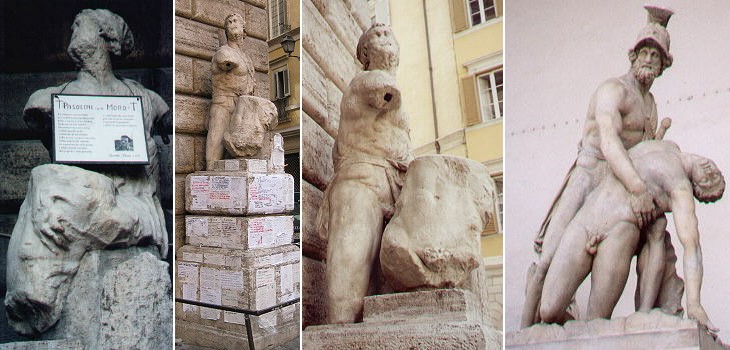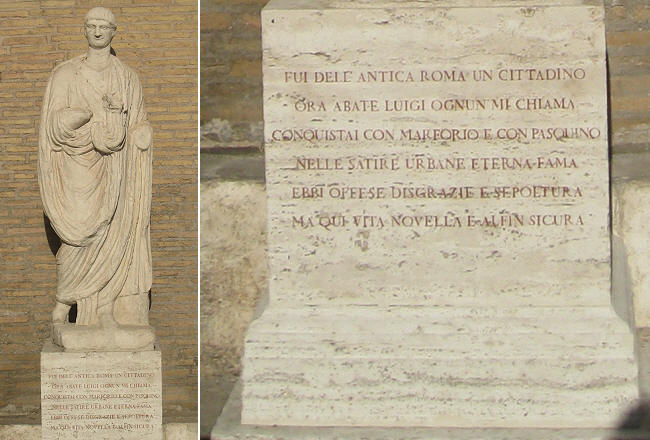
All images © by Roberto Piperno, owner of the domain. Write to romapip@quipo.it.
Notes:
Page revised in October 2020.

All images © by Roberto Piperno, owner of the domain. Write to romapip@quipo.it.
Notes:
Page revised in October 2020.
 which still occasionally talk!
which still occasionally talk!
In the first half of the XVth century the popes gained direct authority over the government of Rome and they assumed the dual role of
spiritual and civil leaders. This dual role was later on formalized in the sentence In Nome del Papa Re (in the name of the Pope King). In his role as a king, the pope
was exposed to criticism and this was soon voiced by the Romans through very short compositions in verse ridiculing or otherwise blaming the behaviour of the popes.
Nicholas V was one of the first popes whose action, the bloody repression of a conspiracy, was sharply criticized in a short poem.
The anonymous authors of the poems were often very close to the pope and had direct knowledge of confidential information. A little poem suggested the title of Padre della Patria (Father of the Nation) to be given to Pope Innocent VIII because of his sixteen natural children.

(left/centre) Pasquino; (right) Menelaus and Patroclus in Loggia della Signoria, Florence
In 1501 Cardinal Oliviero Carafa put the torso of a statue representing Menelaus with the body of Patroclus in a small square near his residence.
Each year on April 25 the Cardinal chaired a sort of Latin
literary competition and poems were posted on the statue and occasionally this happened outside the competition period. In this way
Pasquino (the name given to the statue) became the first talking statue of Rome and it is still used from
time to time for posting messages and claims. The square is named after him Piazza di Pasquino and pasquinata (pasquinade) is the word used for a short satire exhibited in a public place.
Pasquino soon became very popular and especially during the conclaves every night new gossips were posted to influence the election
of the new pope. Pope Adrian VI considered
throwing Pasquino into the Tiber and other popes had similar thoughts, but they feared to fall into ridicule by punishing a statue. Severe laws however were issued to stop the practice and Pasquino was put under
surveillance.
This led to the undesired result of multiplying the talking statues of Rome.
The colossal statue of a river-god at the foot of the Capitoline Hill became soon a second Pasquino. It was named Marforio and it added zest
to the lampooning of the popes as Pasquino and Marforio started talking to each other. In 1679, with the excuse of preserving a fine antique statue, Marforio was incarcerated inside Palazzo Nuovo di Campidoglio.
Pope Clement XI was so interested in Urbino, his hometown, that Pasquino and Marforio had this little conversation:
Marforio:- Dimmi: che fai Pasquino? (Pasquino, tell me: what are you doing?)
Pasquino:- Eh, guardo Roma, chè non vada a Urbino. (I watch over Rome, to make sure it's not moved to Urbino)
The mutilated marble bust of a colossal statue of a
priestess of Isis near Chiesa di S. Marco became known as Madama
Lucrezia and it provided a female character to the little choir of the talking statues, which was called il Congresso degli Arguti (the Shrewd Congress).
The most famous pasquinade is with no doubt
The target of the pasquinade was Pope Urban VIII Barberini who (with the excuse of a restoration) had taken bronze decorations from the Pantheon for the Canopy of S. Pietro.
The only talking statue which is not an ancient Roman statue is Il Facchino (The Porter) which ought to be called L'Acquaiolo (The Seller of Water) which portrays a Renaissance seller of water with his little cask. This trade declined at the end of the XVIth century when Pope Sixtus V started reactivating the ancient Roman aqueducts. The statue is located in Palazzo De Carolis in Via del Corso.

Abate Luigi
The ancient statue of an unidentified emperor (the head, a cast, belongs to another statue and it has been often stolen) was allowed to talk to Pasquino and Marforio. The statue is commonly known as l'Abate Luigi. It is located near S. Andrea della Valle.

(left) Via del Babuino leading to Piazza del Popolo; (right) il Babuino
Via del Babuino is named after an ancient statue of Silenus,
the drunken companion of Dionysus, which was referred to in derogatory terms
as il Babuino (Baboon).
Its location in the Strangers' Quarter of Rome made it an alternative site for posting pasquinades without a high risk of being caught. Il Babuino was also
used by the large community of foreigners living in the area for lampooning members of the community.

